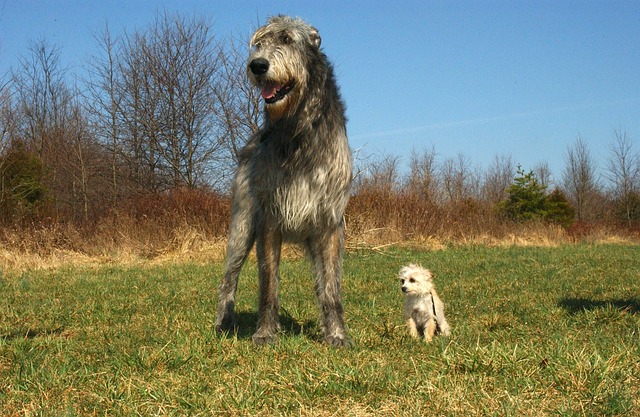


The Irish Wolfhound is one of the largest and oldest dog breeds, known for its impressive size and gentle nature. Originally bred to hunt large game such as wolves, deer, and boars, this breed has a noble and calm demeanor, making it a great companion for families. Despite its intimidating size, the Irish Wolfhound is affectionate, friendly, and typically good with children and other pets. Its majestic appearance and friendly temperament have earned it admiration worldwide.
The Irish Wolfhound's history dates back to ancient times, with records of the breed in Ireland dating as far back as 500 AD. These dogs were originally bred to hunt large game, particularly wolves, which were common in Ireland. The breed is believed to be a mix of several ancient hound breeds, including the Mastiff and the Greyhound, resulting in the Irish Wolfhound’s unique combination of size, speed, and strength. The dogs were highly valued for their ability to protect livestock and hunt dangerous game. As wolves were driven to extinction in Ireland in the 18th century, the need for the Irish Wolfhound diminished, but the breed was carefully preserved by enthusiasts. Today, the Irish Wolfhound is primarily kept as a companion and show dog, though it still retains its impressive hunting heritage.
The Irish Wolfhound is a giant breed, standing between 32 to 34 inches at the shoulder for males and slightly smaller for females. They typically weigh between 120 and 180 pounds, with some individuals reaching even greater weights. Despite their massive size, they are lean, athletic dogs with a graceful appearance. Their coat is rough and wiry, typically gray, brindle, red, black, white, or fawn. The breed’s head is large, with a distinctive beard and eyebrows, and their long tail is carried low. The Irish Wolfhound's deep chest, strong legs, and muscular build give it the power and stamina required for its historical purpose as a hunting dog. Their size and stature make them one of the most recognizable and awe-inspiring dog breeds.
Although the Irish Wolfhound is a giant dog, it is known for its gentle, calm, and friendly temperament. Often described as a "gentle giant," this breed is affectionate with its family and is typically good with children. They are generally calm and laid-back indoors but enjoy spending time outside, especially if there is room to roam. Despite their hunting background, Irish Wolfhounds are usually friendly toward other dogs and pets, although their large size and strength mean that supervision is necessary in mixed pet households. They are not aggressive by nature and are more likely to be affectionate and patient, making them excellent companions for families looking for a larger, more docile breed.
The Irish Wolfhound is an active breed that requires regular exercise to stay healthy, but due to its large size, it is important to provide appropriate, low-impact exercise. While the breed enjoys running and playing, especially in large, secure areas, their exercise needs are typically moderate compared to other active breeds. Daily walks, along with opportunities for free running in a safe, enclosed area, are essential to their well-being. However, because of their size, it is important not to over-exercise them when they are young, as this can stress their developing joints and bones. As they grow older, they may become less active, but regular, moderate exercise will help them maintain muscle tone and prevent weight gain. Mental stimulation is also important, as Irish Wolfhounds enjoy puzzle toys and games that engage their mind.
Irish Wolfhounds are intelligent and generally eager to please, which makes them fairly easy to train. However, because of their independent nature and giant size, training must be consistent, positive, and patient. Early socialization is crucial for Irish Wolfhounds to help them become well-rounded and confident adults. Exposure to different people, animals, and environments will ensure they are comfortable and well-behaved. While they are typically friendly and good with children, socialization helps them learn proper behavior and manners. Training should be done using positive reinforcement methods, as harsh training techniques can cause the breed to become stubborn or overly sensitive. Irish Wolfhounds are not typically suited for off-leash training in unconfined spaces, due to their prey drive and size.
The Irish Wolfhound is a relatively healthy breed, but like many large dogs, it can be prone to certain health issues. Some of the most common health problems in the breed include hip dysplasia, heart conditions such as dilated cardiomyopathy, bloat (gastric torsion), and certain types of cancer. Regular veterinary check-ups and a healthy diet are crucial for managing these health risks. It is important to feed Irish Wolfhounds a high-quality, balanced diet designed for large breeds to support joint health and overall well-being. Due to their rough coat, they require regular grooming, including brushing a few times a week to prevent mats and tangles. Additionally, keeping their nails trimmed, ears clean, and teeth brushed is essential for maintaining their health.
The Irish Wolfhound has a relatively short lifespan compared to smaller dog breeds, with an average life expectancy of 6 to 8 years. This shorter lifespan is partly due to the breed’s large size, as larger dogs generally age more quickly than smaller ones. However, with proper care, many Irish Wolfhounds can live long, happy lives. Regular veterinary visits, a healthy diet, and appropriate exercise can help ensure that an Irish Wolfhound enjoys its later years in good health. It is important for owners to be aware of potential health issues that may arise as the dog ages, particularly those related to joint health and heart conditions.
© copyright Dog Compendium 2024 - 2025